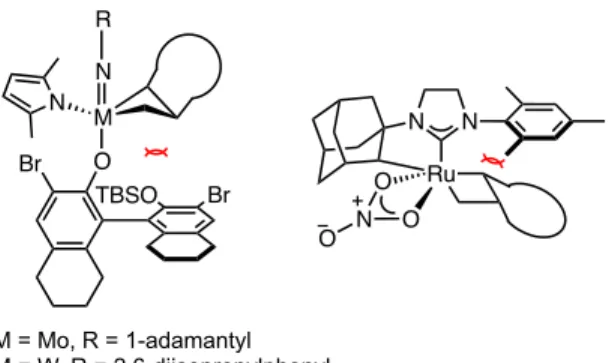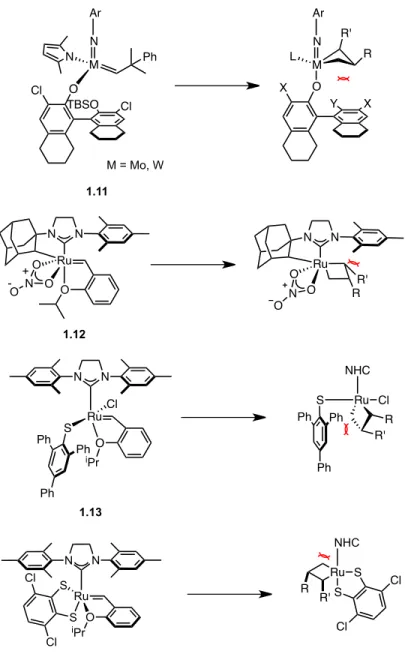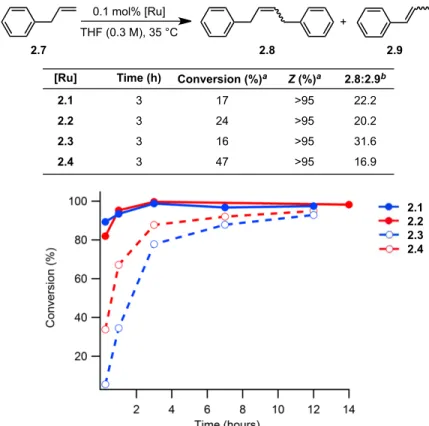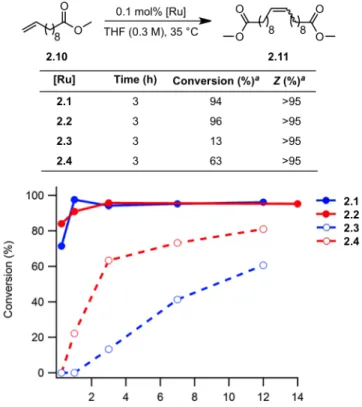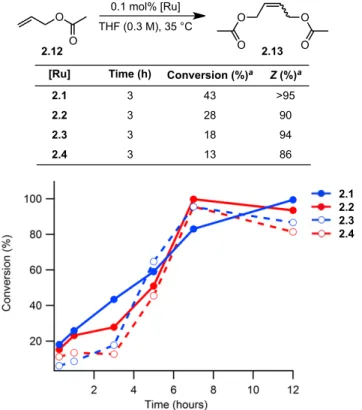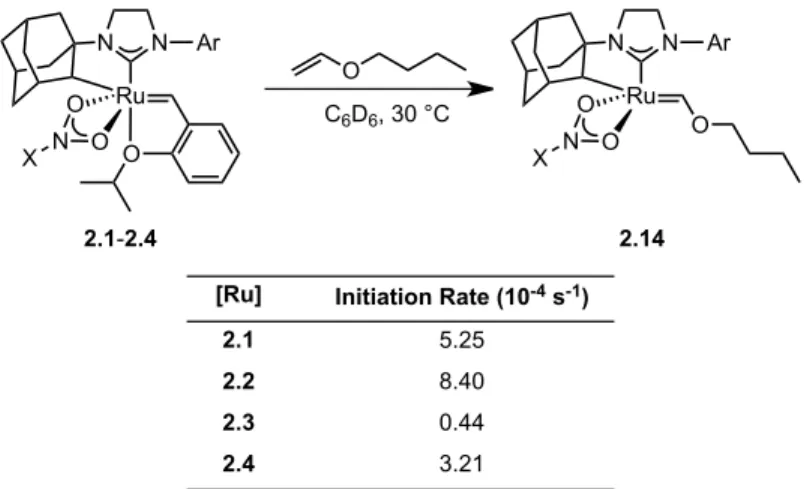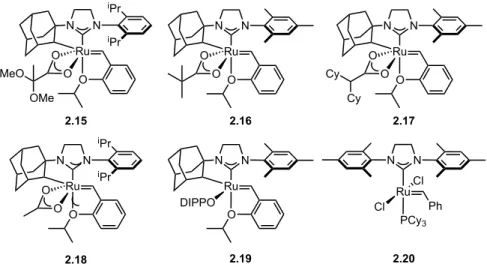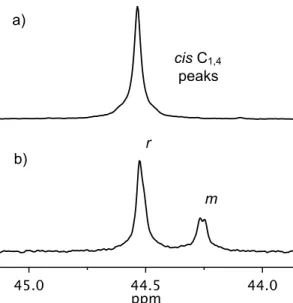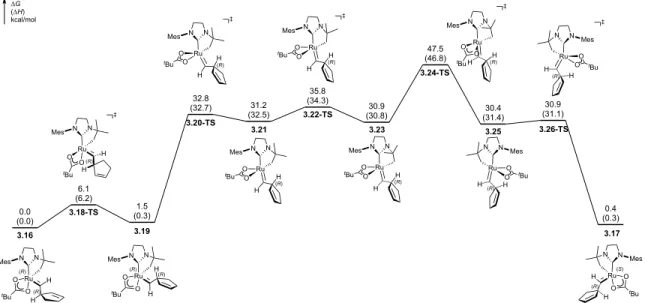I would like to thank him for his unwavering support, which I know will continue into the future. I want to thank Allegra for her friendship and also for editing documents I wrote. I would like to thank Nathan and Billy for always having my back through the tough times.
Last but not least, I would like to thank my family for all their love and support. I want to thank my sister Nadia for her support throughout my life and for calling me to be her personal Shazam.
Introduction
In 1971, Yves Chauvin proposed the now widely accepted mechanism of olefin metathesis (Scheme 1.2).10 He argued that the identity of the catalyst is a metal alkylidene which reacts with an olefin in a [2+2] cycloaddition to give a metallacyclobutane intermediate . Identification of the proposed metal alkylidene as a catalyst for this reaction enabled the development of well-defined, homogeneous olefin metathesis catalysts.11 Over the past few decades, early and late transition metal-based alkylidenes have been synthesized to catalyze olefin metathesis reactions (Figure 1.1).12–15. The work carried out in our group focuses on the development and use of well-defined Ru-based olefin metathesis catalysts.
In general, specific questions about the identity and the characteristics of intermediates in olefin metathesis need to be answered for specific systems where catalyst decomposition is common, such as in the ring-opening metathesis polymerization reactions in the synthesis of functionalized materials. This will further expand the utility of olefin metathesis to an increasing number of applications.
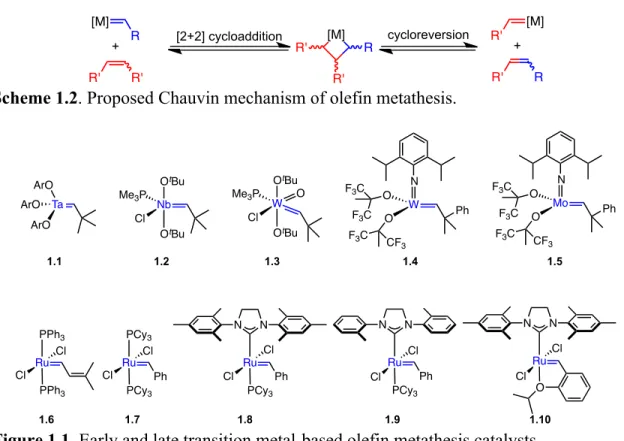
Z-Selective Ruthenium Metathesis Catalysts: Comparison of Nitrate and
Although catalysts 2.3 and 2.4 showed slower initiation rates than 2.1 and 2.2, they maintained remarkable cis-selectivity in homodimerization and ring-opening metathesis polymerization reactions. Both catalysts 2.3 and 2.4 were found to be slower than the nitrate analogues, reaching 88% and 78% conversions, respectively, after 3 hours. There is no apparent difference in the conversion rate for catalysts 2,2–2,4 for allyl acetate.
Initial rates of the reaction of catalysts 2.1–2.4 with butyl vinyl ether as determined by 1H NMR spectroscopy. In summary, salt metathesis of I–ruthenium complexes 2.5 and 2.6 with AgNO2 results in stable, chelated Z–selective ruthenium olefin metathesis catalysts 2.3 and 2.4.
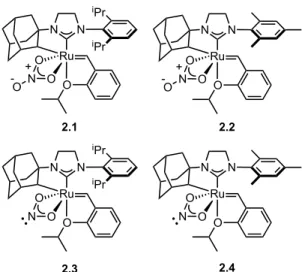
Probing Stereoselectivity in Ring-Opening Metathesis Polymerization
However, we found that the concentration of 3.10 had very little noticeable effect on the microstructures of the polymers produced by catalyst 3.2 (Table 3.3). Formation of a trans, isotactic dyad resulting from the syn approach of the monomer to the anti alkylidene (R = o-isopropoxyphenyl). Isomerization of the alkylidene trans to NHC leads to the highly unstable intermediate 3.21.
Because the barriers to alkylidene rotation in catalysts 3.1 and 3.2 with monomer 3.10 are comparable (cf. Table 3.8), this correlation is likely a result of the relative differences in the energies of the propagating transition states for each catalyst (which also determine both cis. and syndioselectivity). Linear relationship between cis content and tacticity of the cis regions of poly(DCNBD) (poly-3.10) for catalysts 3.1–3.8 (data taken from Table 3.2).
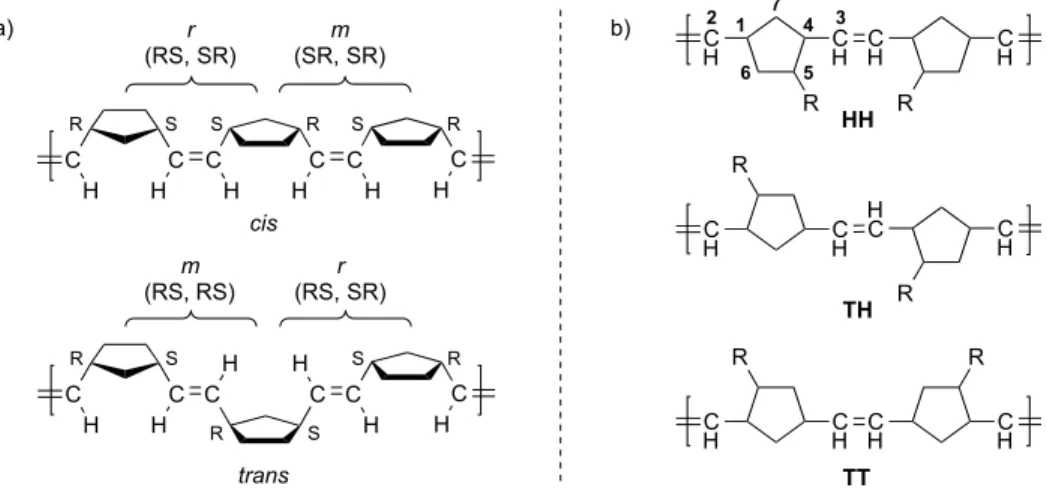
Metathesis and Decomposition of Fischer Carbenes of Cyclometalated Z-
The results of this reaction mirrored the observations of the reactions with phenyl vinyl ether. The disappearance of the 1H signal corresponding to the benzylidene proton at 4.3 and the appearance of a broad peak of the proposed Fischer carbene at 13.83 ppm were observed.21 The subsequent disappearance of this signal and the simultaneous appearance of a new signal at -12.62 ppm indicated the formation of the hydride species in quantitative yield. Possible decomposition pathways for the Fischer carbene complexes under reaction conditions to form Ru hydride complexes 4.13 or 4.14 from insertion intermediate 4.12.
Further supporting this proposed structure, the hydride showed correlations with alkenyl carbons, the carbene carbon of NHC, and a methylene carbon of the butyl group in 1H-13C HMBC. Reaction of catalyst 4.3 with 0.1 equivalent of butyl vinyl ether in THF-d8 leads to quantitative conversion of the butyl vinyl ether to 4.15, indicating that an excess of vinyl ether is not necessary for decomposition. The rate-limiting step of initiation is retro-[2+2] to form free 2-isopropoxystyrene.25 The calculated barrier for this step in the reaction of 4.3 with phenyl vinyl ether is 23.4 kcal/mol.27 Therefore, initiation is clearly slower than carbene exchange.
During the decomposition process, only a small portion of the catalyst will be initiated in 4.9, then the remaining vinyl ether will react rapidly with 4.9, epimerizing the complex in 4.18 (leading to the hydride 4.15). The presence of hydrides can potentially lead to degradation of Z-olefin content or olefin migration. After obtaining a 1H NMR spectrum after 10 min to see the initial formation of the Fischer carbene, the reaction to form the Ru-H complex was completed overnight at room temperature.
A 1H NMR spectrum was taken after 10 min at 0 °C to see the initial formation of the Fischer carbene. Carrying out this reaction at 0 °C allows the observation of a very small signal at 13.57 ppm (2% relative to the signal at 13.83 ppm) in the 1H NMR spectrum, which may possibly belong to another isomer of Fischer carbene. 14 discusses the direct epimerization of the ruthene center via reorientation of the alkylidene in the Supporting Information.
Inspired by the lack of reactivity between 5.2 and trans substrates, and in agreement with the proposed model (vide infra), we attempted to investigate the effect of reducing the steric bulk of the NHC ligand. Limiting the decomposition of the catalyst in the presence of terminal olefin, in addition to surpassing the self-metathesis of the desired product, has been a challenge.
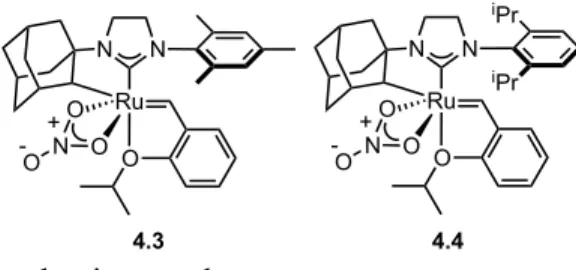
Fast-Initiating, Ruthenium-based Catalysts for Improved Activity in
Signals corresponding to benzylidene protons of 6.1 and 6.2 during reaction with trans-2-hexenyl acetate (0.5 M) in THF-d8 at 45 °C. By varying the size of the ortho substituents of the N-aryl groups of NHC, a number of other fast-initiating catalysts and 6.5 were synthesized (Scheme 6.1). To observe changes in the reactivity of catalysts 6.1–6.5, the self-metathesis of the trans isomer of the substrate methyl 9-octadecenoate (MO) to produce dimethyl 9-octadecenedioate (DE) and 9-octadecene (9C18) was examined (Table 61. , entries 1–7).
The self-metathesis of the cis analog of this substrate, Z-methyl 9-octadecenoate, was also analyzed (Table 6.1, entries 8–13). To examine the discrepancy in the rate of reaction of each of these catalysts with the E- and Z-isomers of methyl 9-octadecenoate, we calculated the relative rate constant (kZ/kE) using the times required for the reactions to reach equilibrium (tE and tZ,) and Table 6.1. Thus, reducing the size of the ortho substituents of the N-aryl groups increases the ability of the E-olefin to react with catalysts.
As shown by the reaction with methyl 9-octadecenoate, the reaction of the cis isomers of these substrates, cis-4-octene and cis-1,4-diacetoxy-2-butene (molar ratio 4:1), proceeded significantly easier. than the corresponding trans isomers with the catalysts. The more challenging reaction of the cross metathesis of a disubstituted olefin, trans-4-octene, and a terminal olefin, 1-decene, to generate 4-tridecene was then Table 6.2. As a result, the product yields in this reaction for each of these catalysts did not change significantly after 15 minutes.
The organic byproducts were eluted with 4:1 pentane:diethyl ether, followed by elution of the product with 1:1 pentane:diethyl ether. Extraction of the product with DCM was followed by washing the organic layer with 2M HCl, a saturated aqueous solution of HCl. The lower than expected yield of this reaction could be attributed to self-metathesis of the product, 4-tridecene, to form 4-octene and 9-octadecene as detected by GC.

A Highly Efficient Synthesis of Z-Macrocycles using Stereoretentive,
The organic layer was dried over anhydrous MgSO4, filtered and solvents were removed in vacuo. Butyl vinyl ether (12 µL, 0.090 mmol) was injected into the tube, and the reaction was monitored by observing the disappearance of the benzylidene signal by 1H NMR using an array at the appropriate temperature. Solvents were removed in vacuo, and the product was purified by column chromatography on silica gel (1:49 Et2O: pentane) to afford a colorless oil (12.0 mg, 70% yield).
Solvents were removed in vacuo, and the product was purified by column chromatography on silica gel (1:49 Et2O:pentane) to afford a colorless oil (12.5 mg, 68% yield). Solvents were removed in vacuo, and the product was purified by column chromatography on silica gel (1:49 Et2O: pentane) to afford a colorless oil (94.9 mg, 60% yield). Solvents were removed in vacuo, and the product was purified by column chromatography on silica gel (1:49 Et2O: pentane) to afford a colorless oil (15.6 mg, 70% yield).
Solvents were removed in vacuo and the product was purified by silica gel column chromatography (1:49 Et 2 O:pentane) to give a colorless oil (17.7 mg, 79% yield). Solvents were removed in vacuo and the product was purified by silica gel column chromatography (1:49 Et 2 O:pentane) to give a colorless oil (17.8 mg, 75% yield). Solvents were removed in vacuo and the product was purified by silica gel column chromatography (1:49 Et 2 O:pentane) to give a colorless oil (13.0 mg, 67% yield).
Solvents were removed in vacuo and the product was purified by column chromatography on silica gel (1:49 Et 2 O:pentane) to give a colorless oil (11.7 mg, 52% yield). Solvents were removed in vacuo and the product was purified by column chromatography on silica gel (1:49 Et 2 O:pentane) to give a colorless oil (16.8 mg, 75% yield). Solvents were removed in vacuo and the product was purified by column chromatography on silica gel (1:49 Et 2 O:pentane) to give a colorless oil (16.4 mg, 69% yield).
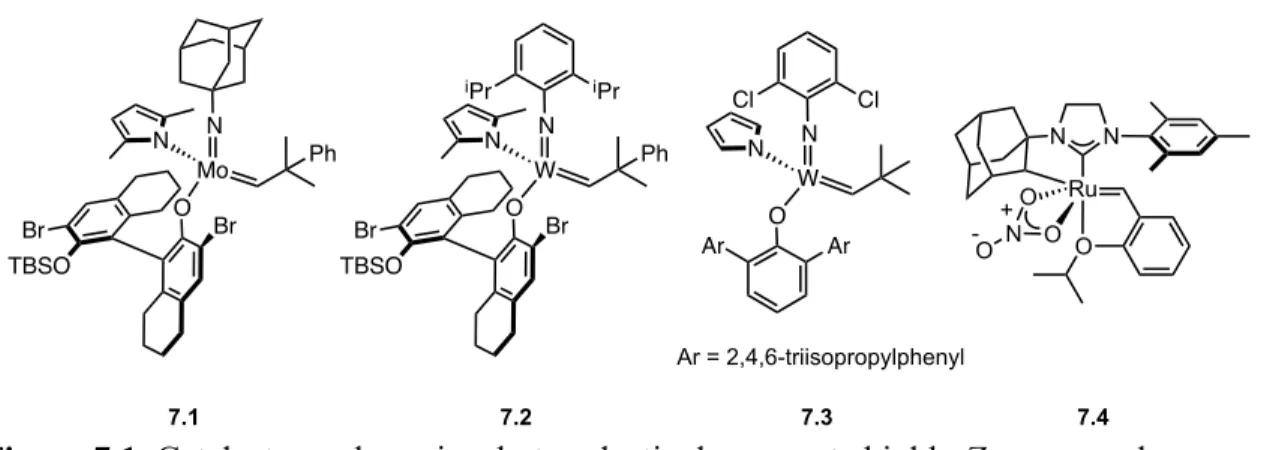
Using Stereoretention for the Synthesis of E-Macrocycles with
Ring-closing metathesis (RCM) has found widespread use in organic synthesis for the production of macrocyclic frameworks.1 This transition metal-catalyzed reaction is commonly used in the synthesis of many biologically active and olfactory compounds.2 The stereochemistry of the olefin often controls the properties of these cyclic molecules. The organic phase was dried over anhydrous MgSO4, filtered and concentrated to give the product as a colorless oil (188 mg, 85% yield). The organic phase was dried over anhydrous MgSO4, filtered and concentrated to give the product as a colorless solid (190 mg, 88% yield).
The organic phase was dried over anhydrous MgSO 4 , filtered and concentrated to give the product as a colorless oil (417 mg, 83% yield). Note: If the reaction did not achieve complete conversion to reduced product, the crude mixture was resubmitted to reaction conditions. The organic phase was dried over anhydrous MgSO 4 , filtered and concentrated to afford the product as a white solid (179 mg, 84% yield). The organic phase was dried over anhydrous MgSO 4 , filtered and concentrated to give the product as a colorless oil (97 mg, 76% yield). Note: If the reaction did not achieve complete conversion to reduced product, the crude mixture was resubmitted to reaction conditions.
The product was purified by column chromatography (5:95 Et 2 O:pentane) to give the product as a colorless oil (201.7 mg, 92% yield). The product was purified by column chromatography (5:95 Et 2 O:pentane) to give the product as a colorless oil (47 mg, 67% yield). The product was purified by column chromatography (5:95 Et 2 O:pentane) to give the product as a colorless oil (68.3 mg, 92% yield).
The product was purified by column chromatography (5:95 Et2O:pentane) to give the product as a colorless oil (51.4 mg, 84% yield). The product was purified by column chromatography (5:95 Et2O:pentane) to give the product as a colorless oil (47.2 mg, 73% yield). The product was purified by column chromatography (5:95 Et2O:pentane) to give the product as a colorless oil (41.0 mg, 77% yield).
